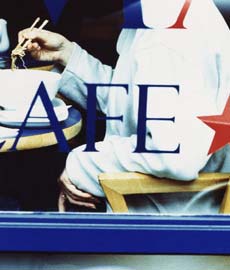Danville-Alamo-Walnut Creek AAUW International Gourmet | Australian Cuisine

Menu: · 6)Stockman's Pie with Mountain Pepper 7)Chocolate Macadamia Delights 8)Sweet Baked Ricotta with Glazed Peaches |
|
We will meet at the Sanchez home on May 21, Saturday, at 6:30 p.m.
International Gourmet Rules: All participants are to share in the costs and preparation. All costs are divided by the number of participants and shared. The hostess provides water, tea, and coffee. If you drink wine, please bring your own. Please arrive on time and help the hostess whenever necessary. Please use the stated ingredients and spices and only substitute when absolutely necessary. Email rkrane@yahoo.com or call 925-552-9799 to chose your preparation item. |
| Welcome - We are celebrating Australia |
"Native Australian Cuisine"? The current revival of "bush tucker" among chefs is making for some of the most creative dishes anywhere in the world. Using indigenous plants and herbs, chefs like Andrew Fielke (formerly of Adelaide's Red Ochre Grill) are finding that bush tomato, sea parsley, riberry and and quandong, a native sweet peach, can make the rich variety of lamb, seafood, pheasant and other meats, fish and fowl into its own unique world-class gourmet cuisine. We are learning about the origins of Australia's bush tucker and Aboriginal favorites, and brush up on your Australian colloquialisms. Otherwise, mate, you might be stuck "looking like a dill." Bush tucker: Bush tucker is Australian terminology for the huge variety of herbs, spices, mushrooms, fruits, flowers, vegetables, animals, birds, reptiles and insects that are native to the country. Some grow wild in the backyards of city homes, others hide their goodness in remote parts of the desert and are difficult to find. |